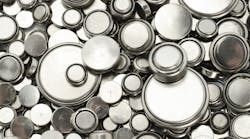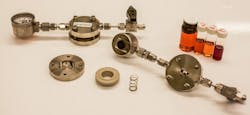Researchers agree that one of the most promising possibilities for future battery technology is the lithium-air (or lithium-oxygen) battery, which could provide three times as much power for a given weight as today’s leading technology, lithium-ion batteries. But tests of various approaches to creating such batteries have produced conflicting and confusing results, as well as controversies over how to explain them.
A team of MIT researchers has carried out detailed tests that point to a cure for lithium-air batteries: a compound called lithium iodide (LiI). The compound was already seen as a possible solution to some of lithium-air battery’s problems, including the inability to sustain many charging-discharging cycles, but conflicting findings had raised questions about the material’s usefulness for this task. The team explains the discrepancies and suggests LiI might not be suitable after all, but they also provide guidance to engineers and scientists trying to overcome LiI’s drawbacks or find alternative materials.
The promise of the lithium-air battery stems from fact that one of the two electrodes, which are usually made of metal or metal oxides, is replaced with the air flowing in and out of the battery. Air serves as an almost weightless substance that replaces a heavy component. The other electrode in such batteries would be pure metallic lithium, a lightweight element.
But Li-air batteries have been limited by three issues: the need for high voltages to charge them; a low efficiency with regard to getting back the amount of energy put in; and low cycle lifetimes, which result from instability in the battery’s oxygen electrode. Researchers have added LiI to the electrolyte as a way of addressing these problems. But published results have been contradictory, with some studies finding LiI improves the cycling life, while others show its presence leading to irreversible reactions and poor battery cycling.
Previously, most research on making lithium-air batteries feasible focused on organics. But most of those organic compounds are not stable. That’s one reason why there’s been a great focus on lithium iodide, an inorganic material, which some research indicates helps batteries last through thousands of cycles. But other research says it will damage batteries.
The team looked at the role of LiI on lithium-air battery discharge using a different approach from most other studies. One set of studies kept the components outside the battery, which let researchers zero in on one part of the reaction, while the other study was done in the battery, to help explain the overall process.
They then used UV and visible-light spectroscopy and other techniques to study the reactions taking place. Both processes fostered the production of different lithium compound such as LiOH (lithium hydroxide) in the presence of both LiI and water, instead of Li2O2 (lithium peroxide). LiI enhanced water’s reactivity and made it lose protons more easily, which promoted formation of LiOH in these batteries and interfered with the charging process. These observations seem to indicate that finding ways to suppress these reactions could make compounds such as LiI work better.
This study could point the way toward selecting different compounds instead of LiI to perform its intended function of suppressing unwanted chemical reactions at the electrode surface.
Lithium-oxygen batteries that run on oxygen and lithium ions are of great interest because they could give electric vehicles much greater range. However, they are not very efficient yet. Still, this study shows how adding a simple salt, LiI, can make these batteries run much more efficiently. It also shows how the lithium iodide helps break up the solid discharge product, which will help in the development of advanced batteries.


